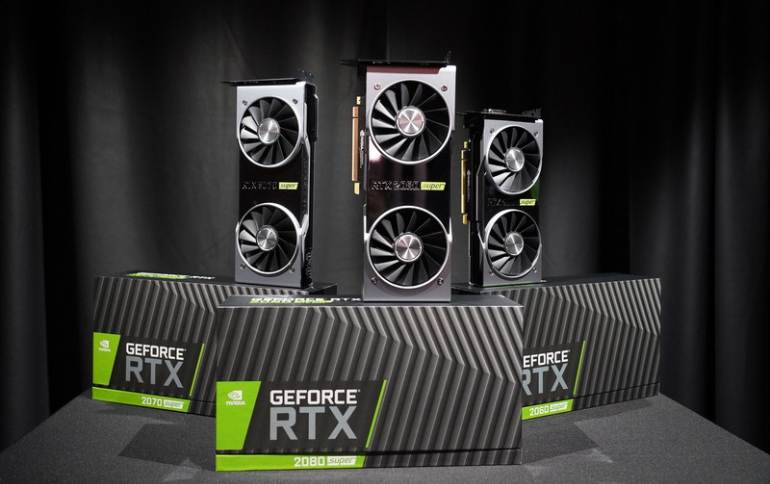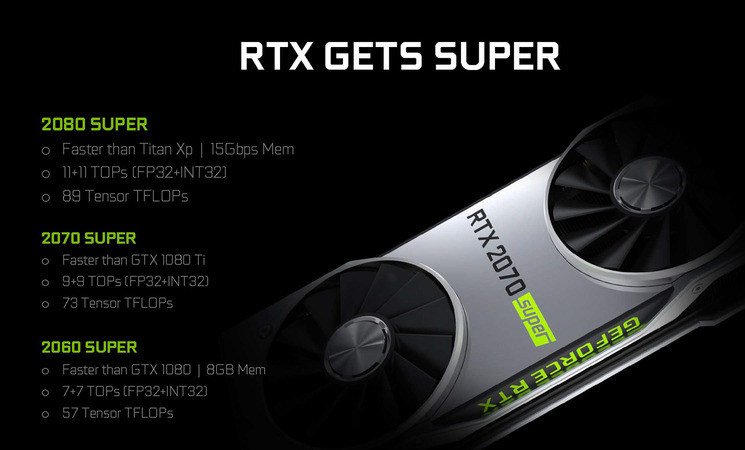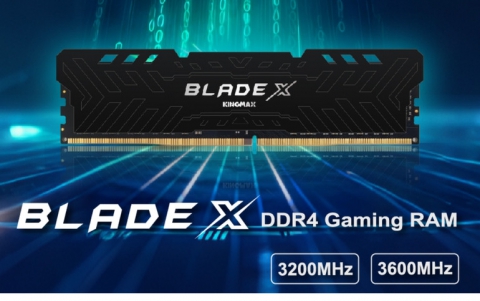
Nvidia's Response to AMD's Upcoming Navi GPU is the new ‘Super’ GeForce RTX Graphics Cards
Nvidia on Tuesday unveiled three “Super” variants of its existing GeForce RTX 20-series graphics cards, along with a new FrameView tool intended to give enthusiasts and reviewers deeper insight into the performance and power consumption of GPUs.
The timing isn’t coincidental, as AMD’s rival Radeon RX 5700 and 5700 XT—the first consumer GPUs built using an advanced 7nm manufacturing technology—launch on July 7.
The new Supre cards are a refresh of existing hardware, still based on the same TU104 and TU106 GPUs that have been on the market since the latter part of 2018.
The RTX 2060, 2070, and 2080 Super desktop cards offer modest speed bumps while maintaining the same price point as the current line of RTX cards, which first hit the market last fall and introduced new visual fidelity and lighting features to PC gaming like real-time ray tracing.

According to Nvidia, the Super cards offer, on average, about 15 percent gains in speed over their non-Super editions, with the upper reaches of the cards’ performance levels achieving between 20 and 25 percent gains depending on your rig. For the RTX 2060 Super, you’ll also be getting 8GB of memory instead of just 6GB, while the 2080 Super will have a higher memory speed of 15.5Gbps over the standard’s 14Gbps.
Nvidia is keeping the prices the same for the 2070 and 2080 lines, so Super versions of those cards will go for $499 and $699, respectively, while the 2060 Super will slot in now at $399, or about $50 more than a standard 2060. The 2060 and 2070 cards launch on July 9th, and the 2080 Super comes out on July 23rd. As part of the sale, Nvidia is also offering a bundle on RTX Super cards with two free games that take advantage of ray tracing: Remedy Entertainment’s Control and Bethesda’s Wolfenstein: Youngblood, both of which come out this summer.

GeForce RTX 2060 SUPER GPU - Starting at $399, Available July 9
- Up to 22% faster (average 15%) than RTX 2060
- 8GB GDDR6 - 2GB more than the RTX 2060
- Faster than GTX 1080 (according to Nvidia)
- 7+7 TOPs (FP32+INT32) and 57 Tensor TFLOPs
GeForce RTX 2070 SUPER GPU - Starting at $499, Available July 9
- Up to 24% faster (average 16%) than RTX 2070
- Faster than GTX 1080 Ti (according to Nvidia)
- 9+9 TOPs (FP32+INT32) and 73 Tensor TFLOPs
GeForce RTX 2080 SUPER GPU - Starting at $699, Available July 23
- Memory speed cranked up to 15.5Gbps
- Faster than TITAN Xp (according to Nvidia)
- 11+11 TOPs (FP32+INT32) and 89 Tensor TFLOPs
| RTX 2080 Super | RTX 2080 | RTX 2070 Super | RTX 2070 | RTX 2060 Super | RTX 2060 | |
| CUDA Cores | 3072 | 2944 | 2560 | 2304 | 2176 | 1920 |
| ROPs | 64 | 64 | 64 | 64 | 64 | 48 |
| Core Clock | 1650MHz | 1515MHz | 1605MHz | 1410MHz | 1470MHz | 1365MHz |
| Boost Clock | 1815MHz | 1710MHz | 1770MHz | 1620MHz | 1650MHz | 1680MHz |
| Memory Clock | 15.5Gbps GDDR6 | 14Gbps GDDR6 | 14Gbps GDDR6 | 14Gbps GDDR6 | 14Gbps GDDR6 | 14Gbps GDDR6 |
| Memory Bus Width | 256-bit | 256-bit | 256-bit | 256-bit | 256-bit | 192-bit |
| VRAM | 8GB | 8GB | 8GB | 8GB | 8GB | 6GB |
| Single Precision Perf. | 11.2 TFLOPS | 10.1 TFLOPS | 9.1 TFLOPS | 7.5 TFLOPS | 7.2 TFLOPS | 6.5 TFLOPS |
| TDP | 250W | 215W | 215W | 175W | 175W | 160W |
| GPU | TU104 | TU104 | TU104 | TU106 | TU106 | TU106 |
| Transistor Count | 13.6B | 13.6B | 13.6B | 10.8B | 10.8B | 10.8B |
| Architecture | Turing | Turing | Turing | Turing | Turing | Turing |
| Manufacturing Process | TSMC 12nm "FFN" | TSMC 12nm "FFN" | TSMC 12nm "FFN" | TSMC 12nm "FFN" | TSMC 12nm "FFN" | TSMC 12nm "FFN" |
| Launch Date | 07/23/2019 | 09/20/2018 | 07/09/2019 | 10/17/2018 | 07/09/2019 | 1/15/2019 |
| Launch Price | $699 | $699 | $499 | $499 | $399 | $349 |
Currently, the RTX 2080 Ti is still the top-of-the-line GPU you can buy, and that doesn’t change with the introduction of Super cards. The RTX 2080 Super, on the other hand, is better than the current 2080 and faster than a Titan Xp, the company says. The 2070 Super is more performant than a GeForce 1080 Ti, but not as good as that standard 2080.
GeForce RTX GPUs support multiple gaming features. In addition to being the only GPUs capable of real-time ray tracing, they deliver an order of magnitude increase in AI processing performance with NVIDIA Deep Learning Super Sampling (up to 130 Tensor TFLOPS of horsepower), and are also the only ones that support advanced features including Mesh Shading and NVIDIA Adaptive Shading (NAS).
NAS also supports Variable Rate Shading, including motion and content adaptive shading for the highest performance and image quality, as well as Foveated Rendering, which puts the detail where the gamer is looking when used in combination with eye-tracking, to deliver VR experiences.
All NVIDIA GPUs come with GeForce Experience. GeForce Experience includes NVIDIA Highlights, which automatically captures the best gaming moments; NVIDIA Ansel, which lets gamers take stunning in-game screenshots; and NVIDIA Freestyle, which lets gamers customize their games’ appearance with more than 15 post-processing filters and 38 different configurations including settings for image sharpening, color blindness and photo-realism. Gamers can even use the special night mode, which reduces the amount of blue light emitted, so they can get to sleep easier after a night of gaming.
Although we did not have the time to run many benchmarks on the new Super 2060 and 2070 cards, the GeForce RTX 2060 Super seems to be an RTX 2070 in name and in price, delivering virtually identical performance for $100 less than the original RTX 2070. And the GeForce RTX 2070 Super, while not quite a facsimile of the RTX 2080, is offering the RTX 2080’s performance for nearly some $200 cheaper.
FrameView

Alongside the Super cards, Nvidia is also announcing a new performance monitoring tool for enthusiasts dubbed FrameView.
Here’s how Nvidia described FrameView:
“FrameView is a software tool designed to capture and measure performance and power utilization of PC-based graphics hardware. It’s especially useful for measuring frame rates and GPU power usage when running stressful “real world” PC gaming scenarios. FrameView captures performance and power data with minimal overhead so as not to impact frame rates or gameplay. FrameView includes an overlay that shows performance and power metrics as a game is being played. It also allows benchmark runs to be captured and charted in detailed reports.
“FrameView captures game performance metrics including average and percentile frame-per-second (FPS) data for both single- and multi-GPU configurations. Percentile FPS data is valuable for illustrating the severity and frequency of stutters that can interrupt gameplay. FrameView has been optimized particularly for detailed frame time, present, and display scheduling metrics for measuring stutter.
FrameView captures real-time power measurements for both total board power (including graphics memory) and GPU chip-only power through application programming interfaces (APIs), which is publicly available software that communicates with the hardware and returns data. This removes the need for additional, and sometimes costly frame capture and power measurement hardware.”
FrameView works only on Windows 10 currently, but it can monitor games built on OpenGL, Vulkan, or DirectX 9 through 12. The overlay feature doesn’t work on DX9/10 or Vulkan games, however. And Nvidia warns that comparing power results from its GeForce cards and AMD’s Radeon cards is not apples-to-apples.
Nvidia plans to make a beta version of FrameView public on the GeForce website on July 9.





















